Disclosure: This article contains affiliate links. We may earn a commission from purchases at no extra cost to you, which helps our travel content.
The first time I stepped into Bangkok's Chatuchak Weekend Market fifteen years ago, I was overwhelmed – not by the crowds or the heat, but by the symphony of aromas that seemed to be conducting an invisible orchestra around me. That initial trip to Thailand for a digital marketing conference turned into my gateway drug to street food culture worldwide. Since then, I've returned to Bangkok more times than I can count on both hands, each visit deepening my love affair with what I consider the world's greatest outdoor dining scene. What makes Bangkok's street food truly special isn't just the flavors – though they're life-changing – but the entire experience: the sizzle of woks, the colorful plastic stools, the passionate vendors who've perfected single dishes across generations, and the way locals and travelers sit shoulder-to-shoulder in culinary democracy. This guide is my love letter to Bangkok's streets, where some of my most profound travel memories have been created one incredible bite at a time.
Navigating Bangkok's Street Food Landscape
Bangkok's street food scene operates like a living organism – pulsing with energy in different neighborhoods at different times. After years of exploration, I've developed what I call my Street Food Radar – an intuitive sense for finding the good stuff.
The first rule of Bangkok street food hunting: follow the locals. Long lines of office workers on lunch break or families gathering for dinner are your North Star. I've waited 40 minutes for a bowl of noodles beside businessmen in tailored suits and construction workers in dusty boots – that kind of democratic appeal speaks volumes.
Street food in Bangkok clusters around transit hubs, markets, and office districts. Chinatown's Yaowarat Road transforms at sunset into a neon-lit food paradise. Victory Monument hosts clusters of vendors specializing in boat noodles. Silom and Sathorn feed the business crowd with lightning-fast wok skills during lunch hours.
Navigating this landscape requires comfortable footwear – my walking shoes have carried me through countless food adventures. Bangkok's concrete jungle can be punishing on your feet, and nothing ruins a food tour faster than blisters.
The beauty of Bangkok's street food is its transparency – most dishes are prepared right before your eyes. You'll see fresh ingredients, cooking techniques passed through generations, and the care that goes into each plate. This open-air kitchen concept creates trust that's sometimes missing in enclosed restaurant kitchens.
One thing to remember: street food stalls are often hyper-specialized. The vendor making the best som tam (papaya salad) won't also make the best pad thai. This specialization is why quality remains so high – these cooks have been perfecting single dishes for decades.
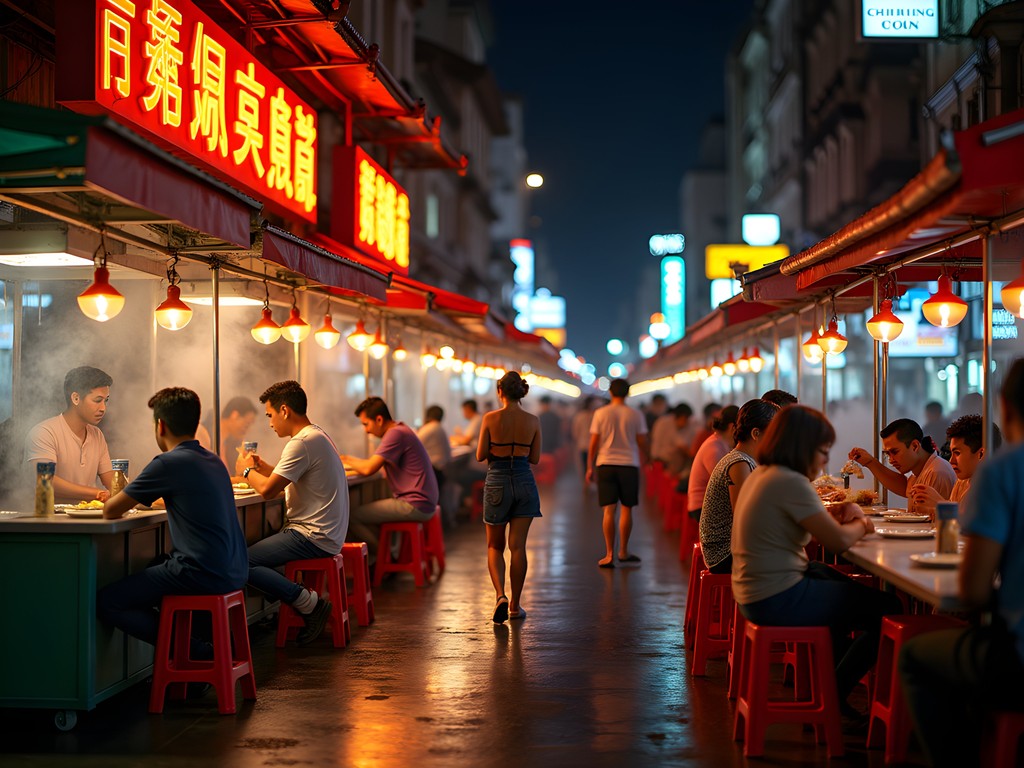
💡 Pro Tips
- Look for stalls with high turnover – fresher ingredients and less time for food to sit
- Carry small bills (20, 50, 100 baht notes) as most vendors don't handle large denominations
- Learn basic Thai food phrases like 'mai pet' (not spicy) if you can't handle heat
The Essential Thai Street Food Dishes
After countless trips to Bangkok, I've developed what I consider my Essential Twenty – the dishes that form the backbone of Thai street food culture. These aren't just tourist favorites; they're the dishes that locals line up for daily.
1. Pad Thai – Let's start with the gateway dish. While it's familiar to Westerners, authentic pad Thai bears little resemblance to its American counterparts. The best versions feature fresh rice noodles with that perfect wok hei (breath of the wok), balanced sweet-sour-savory sauce, and proteins cooked just right. My favorite spot is a humble cart near Thip Samai, where an elderly woman has been making nothing but pad Thai for over 40 years.
2. Som Tam (Green Papaya Salad) – This northeastern dish exemplifies Thai flavor balance: sour lime, spicy chilies, sweet palm sugar, salty fish sauce, and the crunch of green papaya. The vendor pounds the ingredients in a mortar with a rhythmic percussion that announces its creation.
3. Khao Man Gai (Chicken Rice) – Deceptively simple, this poached chicken over fragrant rice is judged by its accompanying sauce – a complex blend of fermented soybean, ginger, chilies, and vinegar.
4. Guay Teow (Noodle Soup) – Available in countless varieties, from the pork-based guay teow moo to the beef-laden guay teow neua. The broth should be clear yet deeply flavored, with rice or egg noodles and various toppings.
5. Moo Ping (Grilled Pork Skewers) – Marinated in coconut milk, fish sauce, and palm sugar before being grilled over charcoal. The perfect breakfast alongside sticky rice.
6. Boat Noodles – Traditionally sold from boats in Bangkok's canals, these intensely flavored, small bowls of noodle soup contain a rich broth fortified with pork or beef blood for umami depth.
To document these culinary treasures, I bring my compact camera which handles low light situations beautifully without intimidating vendors or disrupting the authentic experience.
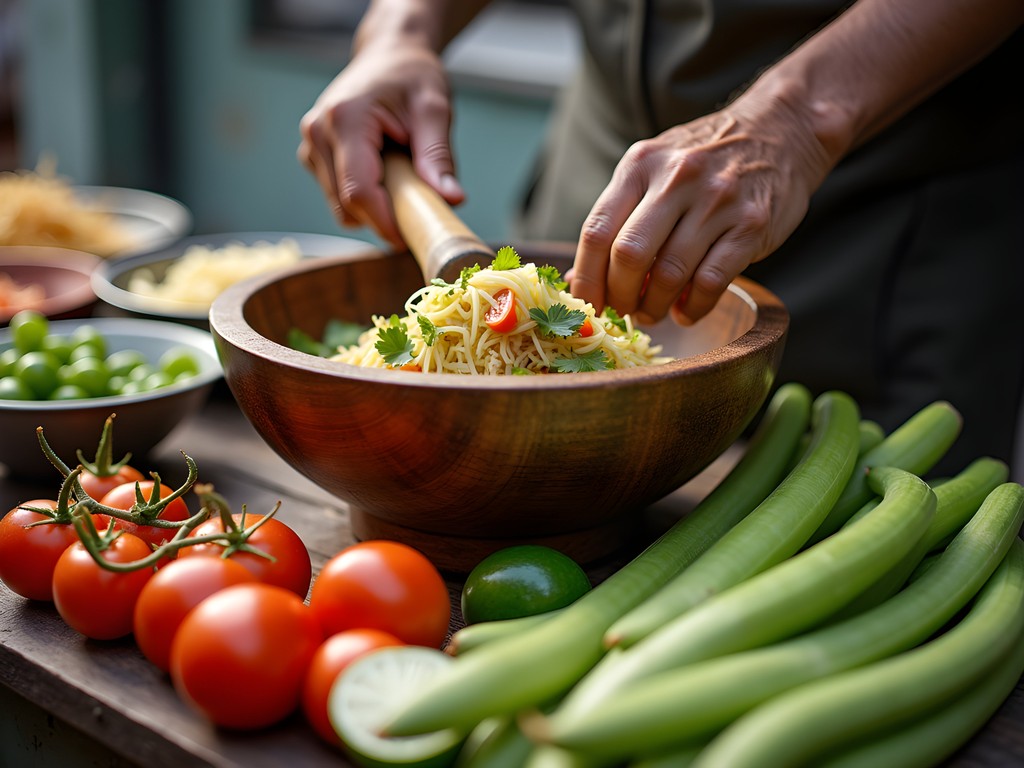
💡 Pro Tips
- Order som tam 'Thai style' rather than 'farang (foreigner) style' if you can handle authentic spice levels
- For the best khao man gai, look for vendors who display whole poached chickens hanging in their stall
- The best moo ping vendors sell out by mid-morning – get there early!
Beyond the Basics: Adventurous Eats
Once you've conquered the street food fundamentals, it's time to venture into more adventurous territory. These dishes might challenge Western palates but reward the brave with unforgettable flavors.
7. Or Suan (Oyster Omelet) – Plump oysters folded into a tapioca starch batter creates a uniquely gelatinous texture that's divisive but beloved. The crispy edges contrast with the soft interior, all enhanced by a sweet-spicy sauce.
8. Larb Moo (Minced Pork Salad) – This Isaan dish combines minced pork with toasted rice powder, lime juice, fish sauce, and fresh herbs. The authentic version packs serious heat from Thai chilies.
9. Hoy Tod (Mussel or Oyster Pancake) – Crispy on the outside, gooey within, these seafood-studded pancakes showcase the Chinese influence on Thai cuisine.
10. Khao Kha Moo (Stewed Pork Leg) – Fall-off-the-bone tender pork leg served over rice with a boiled egg and pickled mustard greens. The collagen-rich meat practically melts in your mouth.
11. Khanom Jeen Nam Ya (Rice Noodles with Fish Curry) – Fresh rice noodles topped with a complex fish-based curry and an array of fresh herbs and vegetables.
12. Yam Pla Duk Foo (Crispy Catfish with Green Mango Salad) – Catfish is fluffed and deep-fried until it resembles cotton candy, then topped with a sour-spicy green mango salad.
When exploring these more unusual dishes, I always carry my water bottle with built-in purification. It's been a lifesaver when I've encountered dishes that ignite my mouth with unexpected heat levels.
I've learned to approach unfamiliar dishes with an open mind and a sense of adventure. During my third visit to Bangkok, I watched an elderly woman preparing or suan with such dexterity that I had to try it despite my initial hesitation about the gelatinous texture. That single decision opened an entirely new dimension of Thai cuisine for me – one where texture plays as important a role as flavor.
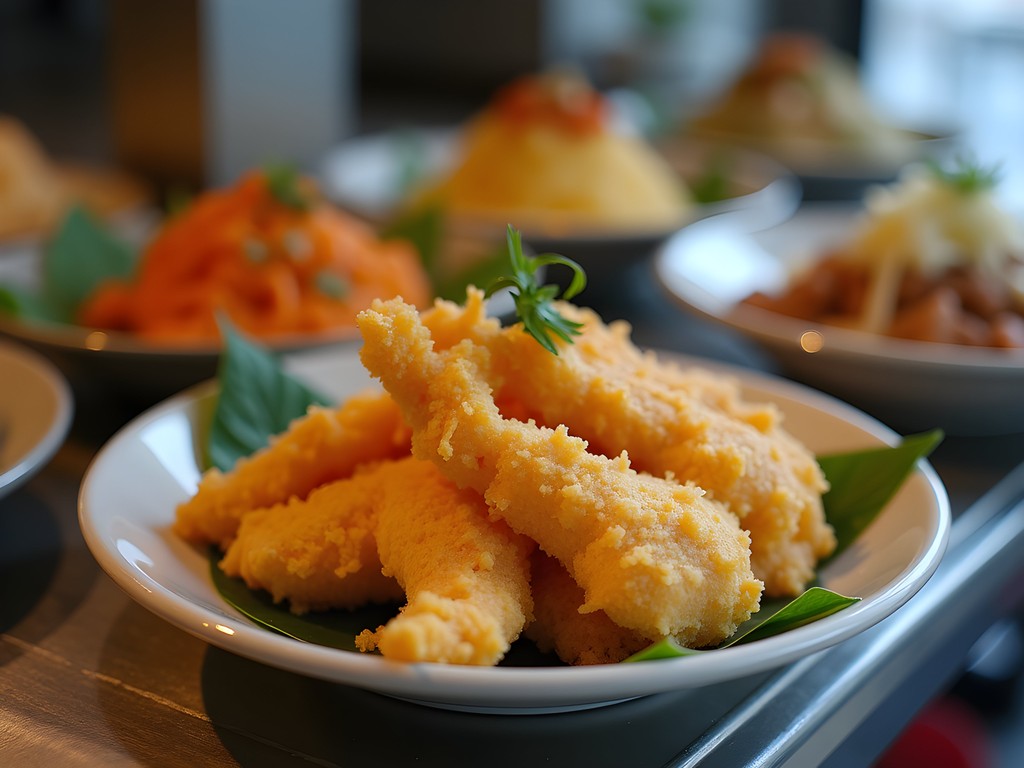
💡 Pro Tips
- When trying larb for the first time, specify your spice tolerance clearly – authentic versions can be volcanic
- Eat khao kha moo with all components together in one bite for the full flavor experience
- The best yam pla duk foo should be eaten immediately while the fish is still crispy
Sweet Endings: Desserts Worth Seeking Out
Thai desserts deserve their own spotlight – they're unlike Western sweets, often incorporating ingredients like mung beans, taro, and pandan that might surprise the uninitiated palate. After fifteen years exploring Bangkok's sweet side, these are my must-try desserts:
13. Mango Sticky Rice (Khao Niew Mamuang) – The ambassador of Thai desserts features sweet sticky rice soaked in coconut milk, paired with perfectly ripened mango. Seasonal availability means the best versions appear March through June.
14. Khanom Buang (Thai Crepes) – Delicate crispy crepes filled with meringue and topped with either savory shrimp or sweet foi thong (egg yolk threads).
15. Roti Gluay (Banana Pancake) – A simple street classic: flatbread stuffed with banana, grilled with margarine, and drizzled with condensed milk and chocolate sauce.
16. Khanom Krok (Coconut Pudding) – Made in special dimpled pans, these half-spheres have a crisp exterior giving way to a soft, custardy coconut interior.
17. Tub Tim Grob (Water Chestnuts in Coconut Milk) – Ruby-red water chestnuts coated in tapioca flour swim in coconut milk with crushed ice – refreshing in Bangkok's heat.
My love affair with Thai desserts began unexpectedly. After a particularly spicy dinner during my first visit, a fellow diner noticed my distress and recommended mango sticky rice as a remedy. That sweet coconut milk immediately soothed my burning mouth, and I've ended every Bangkok food adventure with dessert ever since.
For documenting these colorful treats, I use my smartphone with a clip-on macro lens that captures stunning details without requiring professional equipment. The vibrant colors and intricate textures of Thai desserts make for compelling social media content that inevitably sparks questions from followers.
One evening in Chinatown, I discovered an elderly woman making khanom buang so perfect they resembled edible art. She worked with the precision of a surgeon, creating dozens of these delicate crepes with practiced movements. When I complimented her work through broken Thai and hand gestures, she gifted me an extra crepe with a smile that transcended our language barrier.
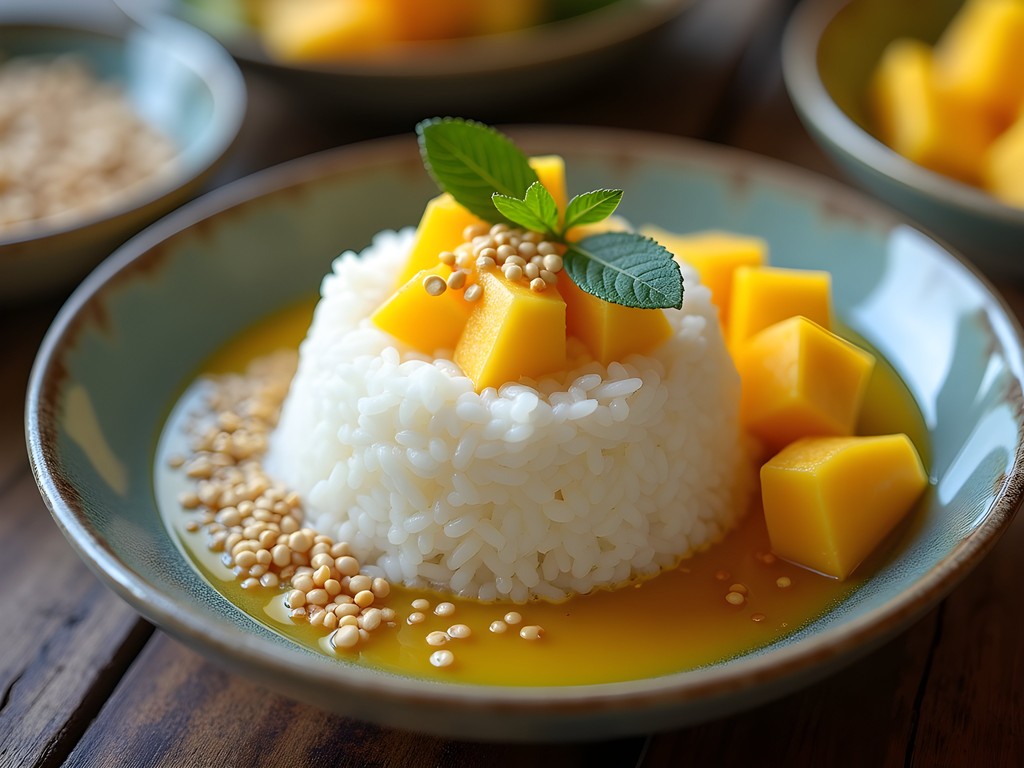
💡 Pro Tips
- The best mango sticky rice vendors are often found near wholesale fruit markets where they can select the ripest mangoes
- Look for khanom krok vendors who add corn or taro as special variations
- Roti vendors often customize fillings – try banana with egg for a protein-rich twist
Drinking Like a Local: Beverages of Bangkok
The full Bangkok street food experience extends beyond eating to a fascinating array of beverages that complement the cuisine and help combat the tropical heat.
18. Thai Iced Tea (Cha Yen) – This iconic orange-hued tea is sweetened with condensed milk and served over ice. The best vendors brew their own tea base rather than using pre-made mixes.
19. Oliang (Thai Iced Coffee) – Unlike Western coffee, oliang is brewed with cardamom and sesame seeds, creating a distinctive flavor profile that's both familiar and exotic.
20. Nam Manao (Lime Soda) – The perfect palate cleanser between spicy dishes, this simple combination of fresh lime juice, sugar syrup, and soda water is endlessly refreshing.
Bonus: Fresh Fruit Juices – From watermelon to sugarcane to coconut, fresh-pressed juices from sidewalk vendors offer immediate refreshment. Watch as they hack open young coconuts with machete precision.
During my second visit to Bangkok, I was battling both the heat and the aftermath of too many chilies when a vendor noticed my discomfort. He quickly prepared a special drink – a mixture of pandanus leaf juice, lime, and a pinch of salt. That single beverage taught me how Thai cuisine thoughtfully provides balance through complementary drinks.
I always pack my insulated tumbler which keeps these icy beverages cold for hours in Bangkok's heat. Plus, it's a small way to reduce plastic waste in a city where single-use cups are unfortunately common.
A word on alcoholic options: while you won't find much alcohol at street stalls (due to licensing), many open-air restaurants serve Leo or Singha beer, the perfect complement to spicy Thai food. For something stronger, look for vendors selling ya dong – herb-infused Thai moonshine served as shots with chaser fruits.
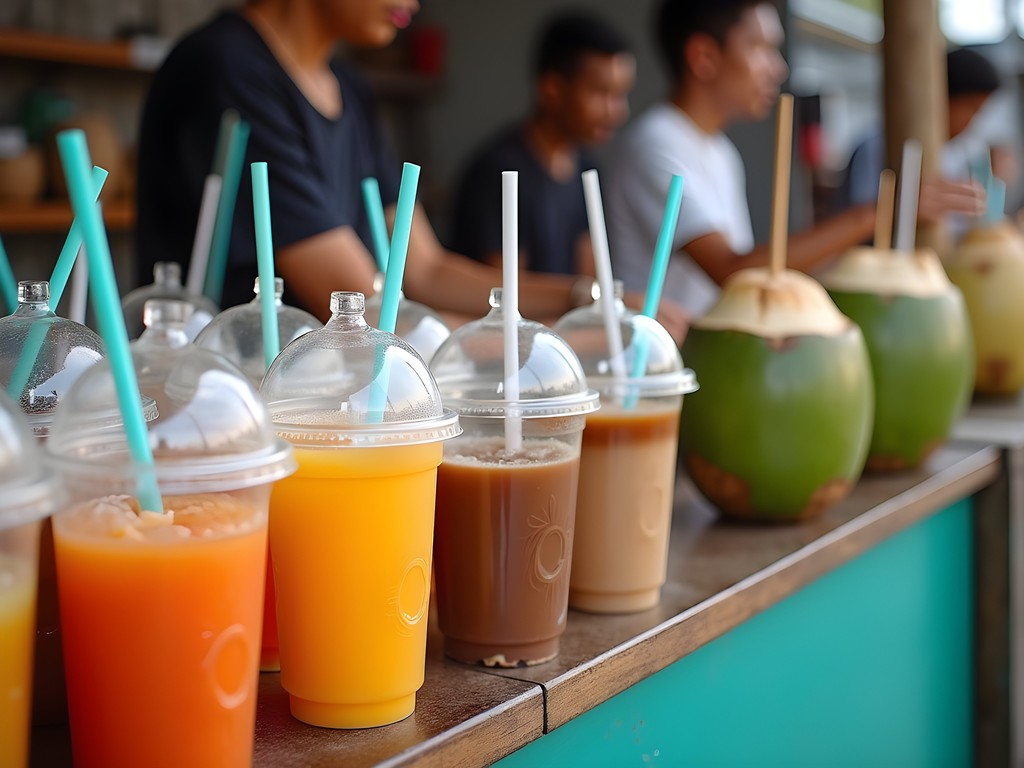
💡 Pro Tips
- Specify 'mai wan' (not sweet) when ordering drinks if you prefer less sugar
- Fresh coconut water is nature's electrolyte replacement – perfect after walking in Bangkok's heat
- Most vendors will let you sample drinks before committing to a full purchase
Navigating Food Safety While Eating Like a Local
Street food safety concerns keep many travelers confined to hotel restaurants – missing the very soul of Thai cuisine. After fifteen years eating my way through Bangkok without a single serious illness, I've developed practical strategies for safe street dining.
First, understand that heat kills most harmful bacteria. Dishes cooked in screaming-hot woks or bubbling soups are generally safe. I'm more cautious with pre-prepared items sitting at ambient temperature.
Water safety is crucial. I avoid ice in drinks unless I can verify it's from filtered water (look for cylindrical ice with holes – this commercial ice typically uses purified water). For raw vegetables and fruits, I choose items I can peel myself or that have been washed in purified water.
Timing matters too. Mornings often feature the freshest ingredients before the tropical heat takes its toll. Similarly, peak meal times ensure high turnover of food – nothing sits around for long.
Observe vendor hygiene practices. Are they handling money and food with the same hand? Do they use different utensils for raw and cooked items? The best vendors maintain clear systems to prevent cross-contamination.
I always travel with a small medical kit including digestive aids just in case, but I've rarely needed them in Bangkok. The fear of street food illness is often overblown compared to the reality.
Perhaps most importantly, ease into the experience. Begin with fully cooked dishes from busy stalls before advancing to more adventurous options. Your digestive system will gradually adapt to new bacterial environments.
The most reliable safety indicator? Local families with children. If Thai parents trust a vendor to feed their kids, that's the strongest endorsement possible.
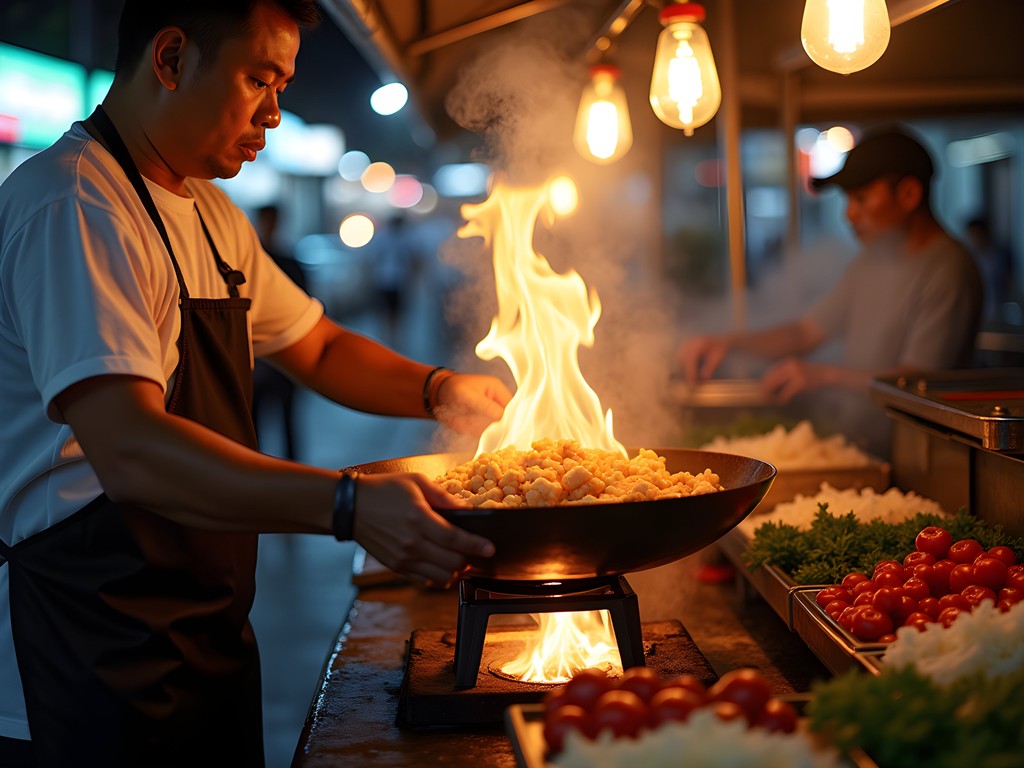
💡 Pro Tips
- Look for vendors who keep raw ingredients refrigerated or on ice
- Busy stalls with high turnover are generally safer than quiet ones with food sitting out
- If you're particularly concerned, stick to dishes you see cooked from start to finish right in front of you
Final Thoughts
Bangkok's street food isn't just sustenance – it's a living museum of culinary traditions, a social equalizer where office workers and taxi drivers dine side by side, and the most accessible way to understand Thai culture. After fifteen years of exploration, I'm still discovering new dishes and vendors on every visit. The beauty of this endless discovery is what keeps drawing me back. Don't approach Bangkok's street food scene with a checklist mentality – instead, follow your senses, embrace spontaneity, and be willing to sit on a plastic stool beside strangers who might become friends over shared dishes. The vendors themselves are the true treasures of this scene – their specialized knowledge and dedication to single dishes represent a form of craftsmanship that's increasingly rare in our world of culinary generalists. So next time you're in Bangkok, step away from the hotel restaurant, bring small bills, an adventurous palate, and a willingness to communicate through the universal language of food appreciation. Your taste buds will thank you, and the memories you create will last far longer than any souvenir.
✨ Key Takeaways
- Follow the locals to find the best stalls – long lines usually indicate exceptional quality
- Most vendors specialize in just 1-2 dishes, perfected over decades
- Street food is generally safe when you choose busy stalls with high turnover and proper cooking methods
- Bangkok's street food is incredibly budget-friendly – a full meal often costs $2-5
- The complete experience includes both savory dishes and unique Thai desserts
📋 Practical Information
Best Time to Visit
year-round, though November-February offers more comfortable temperatures
Budget Estimate
$30-50/day for multiple street food meals and snacks
Recommended Duration
3-5 days minimum to explore different neighborhoods and dishes
Difficulty Level
Beginner (With Basic Street Food Navigation Tips)



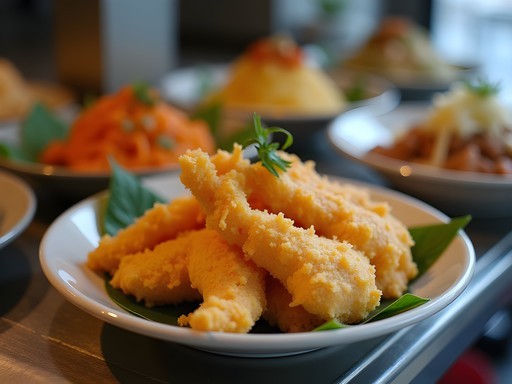
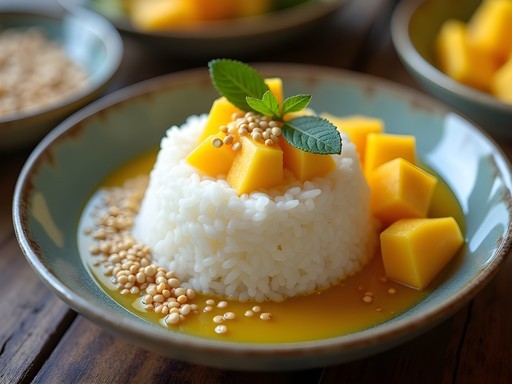
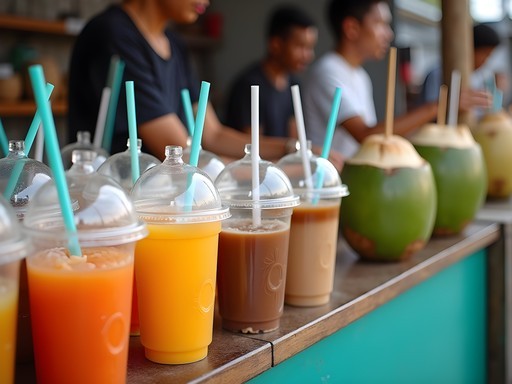
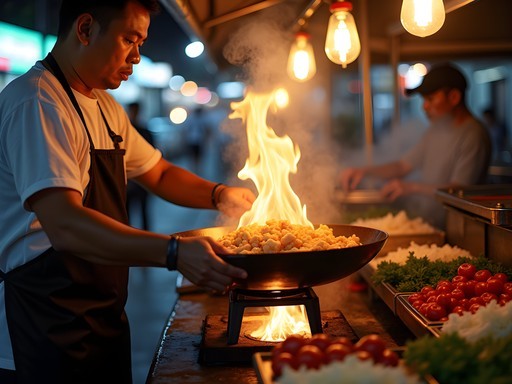


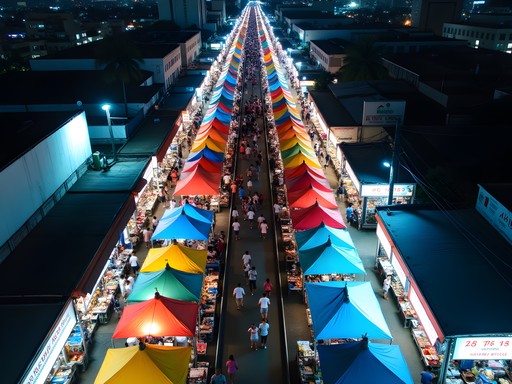


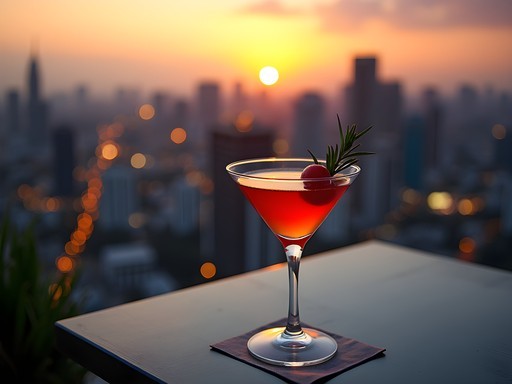


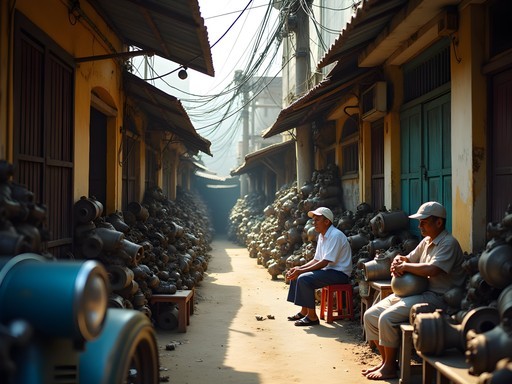

Comments
luckychamp
Just got back from Bangkok last month and this post brought back so many memories! That khao niao mamuang (mango sticky rice) near Thonglor was life-changing. We actually found an amazing spot selling boat noodles near Victory Monument where bowls were only 20 baht! My stomach was a bit sensitive though so I used stomach relief tablets as a precaution. Totally worth it for all that amazing food!
travelwalker
@luckychamp did you try the boat noodles at Victory Monument? That's on my list for my trip in November!
luckychamp
Yes! There's a whole alley of boat noodle vendors. Can't remember the exact name but it's very close to the monument. Just follow the crowds!
Taylor Moreau
Excellent guide, Raymond. As someone who travels to Bangkok quarterly for business, I've found that understanding street food etiquette is just as important as knowing what to order. I always carry small bills for easy payment and try to learn a few Thai phrases - vendors appreciate the effort. The area around Silom during lunch hours is particularly good for authentic meals where local office workers eat. One tip for business travelers: if you're meeting clients, perhaps save the more pungent dishes like pla ra for solo dining adventures!
sunnybackpacker
Great list Raymond! I've tried most of these but still haven't been brave enough for the durian. Any tips for getting past the smell? Also, what area do you think has the best concentration of quality street food?
Raymond Moore
Thanks @sunnybackpacker! For durian, try the monthong variety first - it's milder. As for location, I still think Yaowarat (Chinatown) has the highest concentration of amazing vendors, especially after 6pm. Sukhumvit Soi 38 is great too but more touristy these days.
sunnybackpacker
Thanks Raymond! Will definitely check out Yaowarat at night next time I'm there. Maybe I'll finally brave the durian too!
wavetime
OMG this post couldn't have come at a better time! Heading to Bangkok next week and I'm LIVING for this street food guide!
roamzone
Those night market photos are incredible! Really captures the vibe. Which camera do you use?
Raymond Moore
Thanks! Most of these were actually taken on my smartphone with night mode. The lighting at Thai markets is so vibrant it makes photography easy!
moonguide
Heading to Bangkok next month! Any tips on food allergies? I'm allergic to peanuts but really want to experience the street food scene safely.
Raymond Moore
Great question! I'd recommend getting a food allergy card in Thai to show vendors. Many dishes can be made without peanuts if you ask. Stick to places where you can see the food being prepared and avoid pre-made sauces. Som tam (papaya salad) usually has peanuts but can be made without. Safe travels!
moonguide
Thanks so much for the tips, Raymond! Will definitely get that allergy card made before my trip.
Sage Dixon
Raymond, you've captured the essence of Bangkok's street food scene beautifully! During my last trip, I discovered this tiny stall near Thonglor that served the most incredible khao moo daeng (red pork with rice) I've ever tasted. The elderly couple running it had been there for 40+ years! I've found that some of the best food experiences in Bangkok happen when you follow the locals - if you see a long line of Thai people waiting at a humble cart, join them! You won't regret it. I actually documented my own street food adventures with this pocket translator which helped me chat with vendors and get recommendations from locals. Looking forward to your next food adventure!
roamzone
So true about following the locals! That's how I found the best pad thai of my life - tiny place with plastic chairs but a massive line of office workers.
cityhero2163
Omg those mango sticky rice photos are making me drool! 🤤 Adding all 20 dishes to my bucket list!
globebuddy
Just got back from Bangkok last month and this post is bringing back serious food cravings! Those boat noodles at Victory Monument were life-changing. Raymond, your description of Chatuchak Market is spot on - I was also completely overwhelmed by all the amazing smells my first time there. Did you try the coconut ice cream served in the actual coconut shell? That was my go-to refreshment while exploring the market in that Bangkok heat!
Raymond Moore
Thanks @globebuddy! And yes, that coconut ice cream is essential survival gear at Chatuchak! I think I had it three times during my last visit. Did you try the one with the sweet corn and peanut toppings?
globebuddy
Yes! The sweet corn topping was surprisingly delicious. I was skeptical at first but it works so well!
summerblogger
I'm heading to Bangkok next month for the first time. Any advice for someone with a sensitive stomach? I want to try everything but I'm a bit nervous about getting sick!
wavehero
Look for busy stalls where food isn't sitting around! I have a sensitive stomach too and was fine just avoiding ice and raw veggies.
hikinglegend
Start with the grilled stuff like satay and work your way up. Pad thai is usually a safe bet too!
Raymond Moore
Great advice from everyone! I'd add that places where you can see the cooking happen are usually safer. And don't miss Or Tor Kor market - it's cleaner than most and has amazing quality food!
Venture X
Premium card with 2X miles, $300 travel credit, Priority Pass